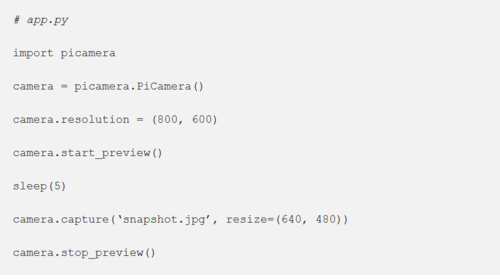Difference between revisions of "OpenCV4"
| Line 57: | Line 57: | ||
*dst = <code>cv.Canny</code>(src, 50, 200, None, 3) | *dst = <code>cv.Canny</code>(src, 50, 200, None, 3) | ||
| − | ==== | + | ==== Houghline Transformation==== |
| + | Using the Canny Edge detection to find the region of interest(edges of the image) prior to the Houghline Transformation,one can now use the Hougline Tranformation: | ||
| + | <code>lines = cv.HoughLines(dst, 1, np.pi / 180, 150, None, 0, 0)</code> | ||
=== Authors === | === Authors === | ||
Revision as of 01:28, 12 December 2018
Contents
Overview
This is a tutorial on how to install OpenCV4 and use camera module.
Materials/Prerequisites
- Raspberry Pi
- Raspberry Pi Camera
Process
Install OpenCV
Follow these instruction[1] to install OpenCV onto your Raspberry Pi using the terminal.
- Important note: don't do
make-j4. It may freeze so it best to just domakeormake-j1.
After you have successfully installed OpenCV, you will be able to use import cv2. If you do it on the terminal, you want to put in these code source ~/.profile and then workon cv.
Capturing image
Following these step to set up your camera[2]
- Note: Ignoring GoPiGo installation.
Once the camera is set up, it is ready to take pictures. In order to capture image, follow these instruction [3]
Note:
- Use
sleep(measured in seconds) to create a delay between the preview:time.sleep(seconds)
- Another way to enable your camera is: go to the terminal → type in
sudo raspi-config→ selectEnable Camera→ press Enter → selectFinish→ reboot and log back on to the Raspberry Pi.
Edge Detector
Once you have a picture, you may want to use edge detection to detect the chessboard region of interest.
Follow these instruction for Canny edge detection[4]
- Note: Scroll down to the Explanation section.
In order to use build-in function in Open CV: remember to import cv2. In the instruction, the import cv2 ascv means that you can now type in cv instead of cv2 when using build-in function.
Use the following build-in code for Canny Detection:
Canny( detected_edges, detected_edges, lowThreshold, lowThreshold*ratio, kernel_size )
Ex: To load image:
- src =
cv.imread(filename, cv.IMREAD_GRAYSCALE)
Then use:
- dst =
cv.Canny(src, 50, 200, None, 3)
Houghline Transformation
Using the Canny Edge detection to find the region of interest(edges of the image) prior to the Houghline Transformation,one can now use the Hougline Tranformation:
lines = cv.HoughLines(dst, 1, np.pi / 180, 150, None, 0, 0)
Authors
- Nhut Dang
- Robert Goodloe
- Ethan Shry(TA)
Fall 2018
